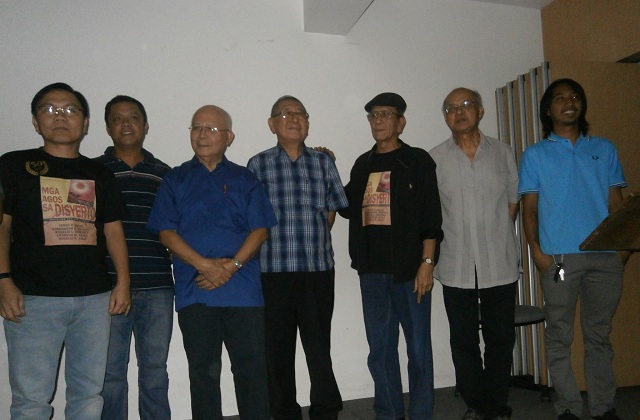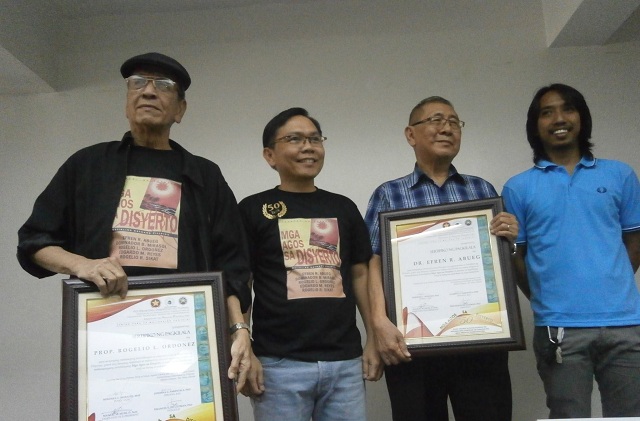Seminal anthology ‘Mga Agos sa Disyerto’ marks 50th year
On the 50th anniversary of the publication of "Mga Agos sa Disyerto," the two remaining authors whose stories were part of the groundbreaking short fiction anthology were honored in a ceremony at the Polytechnic University of the Philippines in Sta. Mesa, Manila last month.
Known for his sense of humor, author and poet Rogelio Ordoñez told the crowd—composed mainly of students from the university—that young writers do not write only to entertain, but also to educate and mobilize society.
His fellow honoree, Efren Abueg, urged the young wordsmiths to not just get involved in the task of writing, but also to take on the role of literary critics.
The title of the event was "Mga Agos sa Disyerto @50: Isang Lektura sa Kahalagahan ng Makabayang Panitikan sa Panahon ng Multimedia at Globalisasyon."
Limang suwail

They were known for the brazen style and content of their short stories, which were like an oasis in the literary desert of the country before the '60s.
"Limang Suwail" was also supposed to be the appropriate title of the novel they were going to write for Bulaklak, the rival magazine of Liwayway, where they were contributing at that time.
The first edition of the anthology that came out in 1964 included Eduardo Bautista Reyes instead of Dominador Mirasol. Each author had three works published.
In the second edition in 1974, Mirasol's stories were added; there were 20 short stories in the anthology.
The third and fourth editions, which came out in 1993 and 2010 respectively, both had 25 stories.
Their short stories delved into the issues of the working class (Ordoñez’s “Buhawi” and “Dugo ni Juan Lazaro”, Mirasol’s “Mga Aso sa Lagarian” and “Makina”, and Reyes’ “Daang Bakal”), the peasants (Ordoñez’s “Inuuod na Bisig sa Tiyan ng Buwaya”, Sikat’s “Tata Selo”, and Reyes’s “Lugmok na ang Nayon”), the indigent (Sikat’s “Impeng Negro”), the women (Abueg’s “Ang Lungsod ay Isang Dagat”, Reyes’ “Ang Gilingang-Bato” and Mirasol’s “Isang Ina sa Panahon ng Trahedya”), and the youth (Abueg’s “Mabangis na Lungsod” and Reyes’ “Di Maabot ng Kawalang-Malay”).
Many of the works were given accolades, like Ordoñez’s “Dugo ni Juan Lazaro” (first prize, Gawad Kadipan, 1962); Abueg’s “Mapanglaw ang Mukha ng Buwan” (third prize, Don Carlos Palanca Memorial Awards for Literature, 1959), “Mabangis na Lungsod” (third prize, Palanca Awards, 1961), and “Sa Bagong Paraiso” (third prize, Palanca Awards, 1963); Reyes’s “Di Maabot ng Kawalang Malay” (third prize, Palanca Awards, 1960) and “Emmanuel” (third prize, Timpalak Liwayway, 1962); Sikat’s “Tata Selo” (second prize, Palanca Awards, 1963) and “Impeng Negro” (second prize, Palanca Awards and first prize, Timpalak Liwayway, both in 1962); and, Mirasol’s“Mga Aso sa Lagarian” (first prize, Palanca Awards, 1964).
The start of a new literary epoch
National Artist Bienvenido Lumbera and International Cultural Studies scholar Epifanio San Juan, Jr. spoke at the event.

He noted that "Mga Agos sa Disyerto" went along “the tradition of social consciousness of Rizal novels and departed in method and temper from the writings of earlier generations." The authors "demonstrated skill in the craft of modern fiction" and their works far exceeded those written in English in terms of "structure, tone and texture."
According to Lumbera, the anthology started a wildfire and commenced a new epoch in Philippine literature. It was living testament that short stories in Filipino were not only "pang-Liwayway."
San Juan’s lecture gave weight to the language in which the stories were written—a critical and moral decision. The authors of "Mga Agos sa Disyerto" chose to write in the language spoken by the masses to help in the mobilization of the majority.
In a desert of malls and global cities, said San Juan, fearless and subversive resistance, protest, and uprising are absolutely necessary.
The event was sponsored by the Institute for Cultural Studies, Center for Creative Writing, and the Office of the Vice President for Research of the Polytechnic University of the Philippines, where Ordoñez and Abueg are teaching. — BM, GMA News




